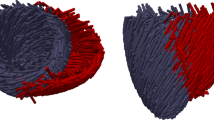Abstract
The large variety in loop morphology of potential differences recorded at the cardiac surface has been generally attributed to structural discontinuities of the tissue. The aim of this work was to examine if the diversity of vector loops of the electric field E found experimentally may also arise during continuous anisotrope conduction. For this purpose a monodomain computer model was used, consisting of a two-dimensional sheet of excitable tissue surrounded with an unbounded volume conductor. Close to the tissue surface our computations predicted a narrow biphasic course of Φe with peak-to-peak separation of less than 400 μm. We examined how accurately E could be reconstructed from measurements recorded with four-element electrode arrays and how activation sequence, interelectrode spacing, and probe orientation affects the results. We found “closed” vector loops of E in planar, and at the apex of elliptical wave fronts, whereas outside of these regions vector loops were “open.” Varying probe orientation and size resulted in substantial changes of vector-loop morphology. We concluded that close to the cardiac current sources accurate measurement of E would require interelectrode distances of less than 100 μm. © 2000 Biomedical Engineering Society.
PAC00: 8719Nn, 8719Hh
Similar content being viewed by others
REFERENCES
Arisi, G., E. Macchi, C. Corradi, R. L. Lux, and B. Taccardi. Epicardial excitation during ventricular pacing. Circ. Res. 71:840–849, 1992.
Bayly, P. V., B. H. KenKnight, G. M. Rogers, R. E. Hillsley, R. E. Ideker, and W. M. Smith. Estimation of conduction velocity vector fields from epicardial mapping data. IEEE Trans. Biomed. Eng. 45 5:563–571, 1998.
Boineau, J. P., C. B. Miller, R. B. Schuessler, W. R. Roeske, L. J. Autry, A. C. Wylds, and D. A. Hill. Activation sequence and potential distribution maps demonstrating multicentric atrial impulse origin in dogs. Circ. Res. 54:332–347, 1984.
de Bakker, J. M. T., R. N. W. Hauer, and T. A. Simmers. Activation mapping: Unipolar versus bipolar recording. In: Cardiac Electrophysiology, edited by D. P. Zipes and J. Jalife. Philadelphia, PA: Saunders, 1995, pp. 1068–1078.
Geselowitz, D. B., R. C. Barr, M. S. Spach, and W. T. Miller III. The impact of adjacent isotropic fluids on electrograms from anisotropic cardiac muscle-A modeling study. Circ. Res. 51:602–613, 1982.
Hofer, E., G. Urban, M. S. Spach, I. Schafferhofer, G. Mohr, and D. Platzer. Measuring activation patterns of the heart at a microscopic size scale with thin-film sensors. Am. J. Physiol. 266:H2136–H2145, 1994.
Hofer, E, I. Schafferhofer, and G. Mohr. The effect of interelectrode distances on measurements of the local potential gradient of the propagating cardiac excitation at a microscopic size scale. Proceeding of the 17th Annual International Conference of the IEEE Engineering in Medicine and Biology Society, 1995 (unpublished).
Hofer, E., G. Mohr, A. C. Jorge, D. Platzer, and I. Schafferhofer. Is the discrete coupling of cardiac cells reflected in the wave front of extracellular potentials? -An experimental approach. Int. J. Bifurcation Chaos Appl. Sci. Eng. 6 9:1767–1773, 1996.
Kadish, A. H., J. F. Spear, J. H. Levine, R. F. Hanich, C. Prood, and E. N. Moore. Vector mapping of myocardial activation. Circulation 74:603–615, 1986.
Kadish, A. H., and J. F. Spear. Identification of conduction block in cardiac muscle: In vitro observations in canine epicardium. Cardiovasc. Res. 28:259–269, 1994.
Leon, L. J., and F. A. Roberge. Directional characteristics of action potential propagation in cardiac muscle. Circ. Res. 69:378–395, 1991.
Leon, L. J., and F. X. Witkowski. Calculation of transmembrane current from extracellular potential recordings: A model study. J. Cardiovasc. Electrophysiol. 6:379–390, 1995.
Luo, C., and Y. Rudy. A model of the ventricular cardiac action potential. Depolarization and their interaction. Circ. Res. 68:1501–1526, 1991.
Mohr, G., E. Hofer, and G. Plank. A new real-time mapping system to detect microscopic cardiac excitation patterns. Biomed. Instrumentation Technol. 33:455–461, 1999.
Spach, M. S., and J. M. Kootsey. Relating the sodium current and conductance to the shape of transmembrane and extracellular potentials by simulation: Effects of propagation boundaries. IEEE Trans. Biomed. Eng. BME-32:743–755, 1985.
Witkowski, F. X., K. M. Kavanagh, P. A. Penkoske, and R. Plonsey. In vivo estimation of cardiac transmembrane current. Circ. Res. 72:424–439, 1993.
Witkowski, F. X., K. M. Kavanagh, P. A. Penkoske, and R. Plonsey. Epicardial cardiac source-field behavior. IEEE Trans. Biomed. Eng. 42:552–558, 1995.
Author information
Authors and Affiliations
Rights and permissions
About this article
Cite this article
Plank, G., Hofer, E. Model Study of Vector-Loop Morphology During Electrical Mapping of Microscopic Conduction in Cardiac Tissue. Annals of Biomedical Engineering 28, 1244–1252 (2000). https://doi.org/10.1114/1.1320841
Issue Date:
DOI: https://doi.org/10.1114/1.1320841




